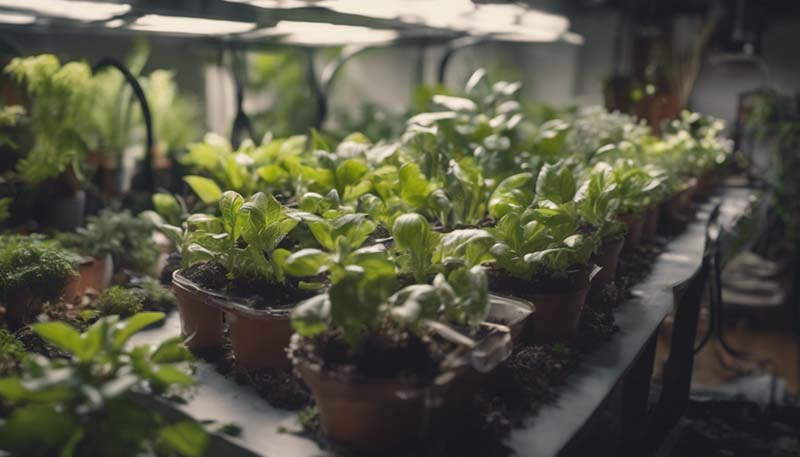The Role of pH in Indoor Gardening
Introduction:
Indoor gardening has become increasingly popular as people seek to grow their own food, enhance their living space, or simply indulge in a rewarding hobby. One of the critical factors that can significantly impact the success of your indoor garden is the pH level of the growing medium. This article delves into the role of pH in indoor gardening, how it affects plant growth, and ways to manage and adjust pH levels for optimal plant health.
What is pH?
The pH scale is a measure of the acidity or alkalinity of a substance. It ranges from 0 to 14, with 7 being neutral. A pH level below 7 indicates an acidic environment, while a pH level above 7 suggests a more alkaline or basic environment. The pH scale is logarithmic, meaning each whole number pH value is ten times more or less acidic/basic than a solution with a pH value that is one unit different.
Advertisement
Why is pH Important in Indoor Gardening?
Plants have specific pH requirements for optimal growth, and understanding these requirements is crucial for successful indoor gardening. The pH level of the soil or growing medium affects a plant's ability to absorb nutrients and water. Some nutrients are more readily available to plants in an acidic environment, while others are more accessible in a more alkaline environment. An imbalance in pH can lead to nutrient deficiencies or toxicities, stunted growth, and even plant death.
Nutrient Availability:
Different nutrients are more soluble at different pH levels. For example, nutrients like calcium, magnesium, and potassium are more available in an alkaline environment, while iron, manganese, and zinc are more available in an acidic environment. If the pH level is not within the optimal range for a particular plant, it may struggle to obtain the necessary nutrients for growth and development.
Soil Microbial Activity:
The pH level also influences the activity of beneficial microorganisms in the soil. These microorganisms play a vital role in breaking down organic matter, making nutrients available to plants, and maintaining soil structure. An imbalance in pH can disrupt the balance of these microorganisms, leading to reduced nutrient availability and poor soil health.
Plant Stress:
Imbalanced pH levels can also cause physiological stress in plants. This stress can make plants more susceptible to diseases, pests, and environmental stressors, such as temperature fluctuations or drought.
Optimal pH Levels for Indoor Plants
Different plants have different optimal pH ranges for growth. Here are some general guidelines for common indoor plants:

- Herbs: 6.0 - 6.5
- Vegetables: 6.0 - 6.8
- Fruiting Plants: 5.5 - 6.5
- Flowering Plants: 6.0 - 7.0
It's essential to research the specific pH requirements of the plants you are growing to ensure you are providing the optimal growing conditions.
Managing pH in Indoor Gardening
Managing pH in indoor gardening can be a bit more challenging than in outdoor gardening due to the closed environment and limited natural processes that help regulate pH levels. Here are some strategies to manage and adjust pH levels in your indoor garden:
1. Start with the Right Growing Medium:
Choose a growing medium with a pH level that is close to the optimal range for your plants. Soilless mixes, such as coco coir or peat moss, can be a good starting point. These materials tend to have a more neutral pH, making it easier to adjust as needed.
2. Regularly Test the pH:
Regularly testing the pH of your growing medium is crucial for maintaining optimal conditions. pH test kits are readily available and can be used to monitor the pH level of your soil or growing medium. Testing the pH every few weeks or after significant watering or fertilization can help you stay on top of any changes.
3. Use pH Adjusters:
If you find that the pH level is outside the optimal range for your plants, you can use pH adjusters to bring it back into balance. For acidic environments, you can use lime (calcium carbonate) to raise the pH. For alkaline environments, you can use sulfur or aluminum sulfate to lower the pH. Always follow the manufacturer's instructions for proper application rates and methods.
4. Monitor Nutrient Levels:
Pay close attention to the nutrients you are providing to your plants. Over-fertilization can lead to an imbalance in pH, as can the use of certain types of fertilizers. Using a balanced, slow-release fertilizer can help maintain a more stable pH level.
5. Leach the Growing Medium:
Occasionally leaching the growing medium can help remove excess salts and nutrients that can contribute to pH imbalances. This process involves thoroughly watering the plants, allowing the water to drain out of the bottom of the container, and repeating this process several times.
Conclusion:
Understanding and managing the pH level in your indoor garden is essential for the health and productivity of your plants. By monitoring pH levels, choosing the right growing medium, and using appropriate pH adjusters, you can create an optimal environment for your indoor plants to thrive.
Comment